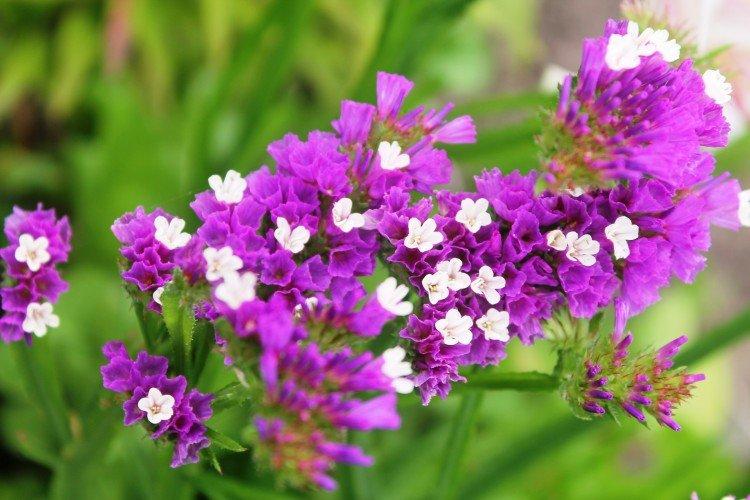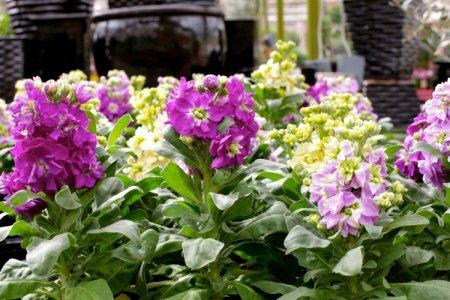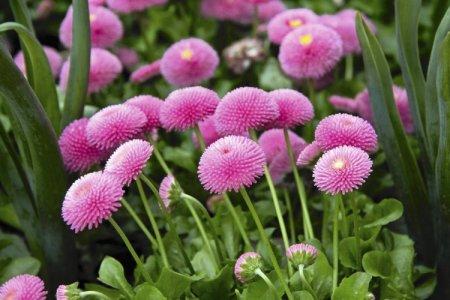
You probably regularly see statice in bouquets and decorative compositions, even if you don't know what kind of flower it is. They fell in love with her for the lush multi-colored bizarre inflorescences. And they are the easiest way to recognize this unusual plant!
general information
Statice or statice are also called immortelle and kermek. These are perennial shrubs up to a maximum of 1.5 m in height. Long, straight leaves are collected in a basal rosette, from which straight and almost naked, but pubescent stems come out.
Statice inflorescences look like spikelets collected from a large number of small cup-shaped flowers. In addition to whites, pinks and purples, there are yellow and other bright shades. Variegated varieties are especially good.

Statice types
The genus statice has about a hundred different species. And there are even more decorative varieties. But we have selected the most common and popular ones!
Ordinary statice
It attracts, first of all, by its long flowering, which lasts all summer. Very small flowers are grouped into large inflorescences-shields.

Notched statice
Medium-sized plants up to 60 cm high and with small flowers up to 1 cm in diameter. The midpoints can be white, and the edges can be blue or purple. Wavy petals appear to be wrinkled.

Suprem
A popular decorative category with the most extensive selection of colors. It is often grown for alpine slides and mixboards, and then dried.

Broadleaf statice
This is a rather large bush that grows into a neat ball up to 80 cm in diameter. It has wide leaves, up to 15 cm, and small, but numerous flowers of all shades of blue and purple.

German perennial statice
Another decorative variety up to 40 cm high for cutting and drying. This species is good for its increased resistance to drought and frost. Flowers always have white cups.

Care of the statice
Caring for the statice is very simple and trivial, because it is an extremely unpretentious garden culture. With the right choice of location, it requires almost nothing!
Temperature and lighting
The statice definitely needs a warm and very bright area. Unlike many more delicate plants, it is not afraid of direct sunlight. But in the shade, it stops blooming and begins to rot.

Watering
The statice is watered very rarely and only in the absence of natural precipitation. Usually this flower has enough rain and morning dew. Pay attention to the lower leaves: if they droop, it's time to water.

The soil
The soil for the statice should first of all be very loose and with a generous drainage layer. It will be useful to dig up the soil in the fall with lime.

Fertilizers and feeding
Due to the sensitivity of the root system to rotting, the statice should not be overfed with fertilizers. A complex mineral mixture can be added at the time of planting. And then from time to time I use liquid top dressing, and only for poor soil.

Wintering
Statice easily withstands frosts down to -30 degrees, and there are even more resistant varieties. Before winter, cut all the shoots right down to the ground and cover the bushes with leaves, spruce branches or straw. On top, you can use a non-woven covering material to protect against excess moisture in the spring during the melting of snow.

Planting and breeding
Most often, statice is grown simply from seeds, because its root system is poorly designed for division and transplantation. Before planting, hard seeds are slightly smoothed with sandpaper and left in wet sawdust for a couple of days.
It is most convenient to sow seeds in peat cups at the end of February, and one cup for each seed separately. Sprinkle them lightly on top and leave warm under the film, periodically moisturizing and airing.After 1.5 weeks, the first shoots will appear.
At the end of spring, when the frost has passed, transplant the seedlings into the garden along with these peat pots. Leave a distance of about 30 cm between them, because the statice grows quickly.

Pest and disease control
When affected by gray rot, the peduncles become brown and droop. Due to fusarium, the plant slows down in growth, degrades and rots. Rust and phyllostictosis progress in the form of red and brown spots on the leaves. These are all fungal infections, and fungicides help with them.
A dangerous statice pest is leaf nematodes. They hide right in the tissues of the leaves and quickly spread throughout the plant, leaving small angular spots. The affected parts must be completely removed, stop spraying and adjust the care.

Statice - photo
The statice in the garden is decorated with flower beds, borders, multi-level compositions and rocky hills. Just look at how impressive her dense plantings look!

























